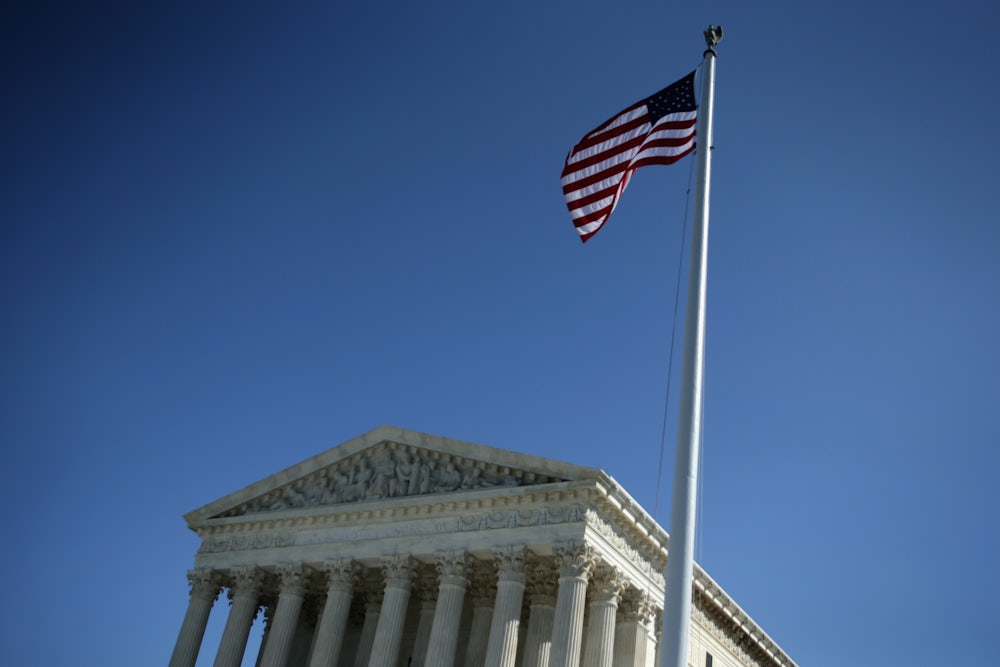Liberals have good reason to be nervous whenever the Roberts Court decides to hear a voting rights case. It has upheld voter ID laws on the one hand, and struck down a crucial provision of the Voting Rights Act on the other. Today, however, was a rare exception. A unanimous Supreme Court refused to strike down Texas’s “one-person, one-vote” reapportionment, foiling an attempt to tilt power toward more conservative areas of the state.
This is good news, but it’s also a qualified victory. The Court’s opinion in Evenwel v. Abbott leaves open the possibility that states could undermine “one person, one vote,” and at least some red state legislatures are likely to try it.
Today’s case concerned the application of the Warren Court’s landmark decisions in Baker v. Carr and Reynolds v. Sims, which require a “one person, one vote” apportionment standard for legislative districts (with the obvious exception of the U.S. Senate, where each state, no matter their size, is granted two senators). Generally, this apportionment is done by measuring total population. A suit brought against the state of Texas, however, argued that the Equal Protection Clause of the Fourteenth Amendment required voters, rather than residents, to be used as the denominator. If this argument had been accepted, it would have had the effect of substantially diluting minority representation—exactly the outcome Baker and Sims were trying to prevent. (Racial minorities and the poor are less likely to vote than whiter and wealthier constituents.)
In a unanimous opinion written by Justice Ruth Bader Ginsburg, the Court rejected this argument. “[T]he rule appellants urge has no mooring in the Equal Protection Clause,” concluded Ginsburg. “Adopting voter-eligible apportionment as constitutional command would upset a well-functioning approach to districting that all 50 States and countless local jurisdictions have followed for decades, even centuries.” For now, these practices will remain in place, and the Supreme Court will not stand the Equal Protection Clause on its head by requiring states to dilute minority representation.
So far, so good. But this doesn’t settle the issue politically. The Supreme Court said that states are not required to apportion legislative district by voters, but it didn’t forbid the practice either. It is very likely that some conservative legislatures will do exactly this in 2020, when the next Census rolls around.
Samuel Alito, the preeminent strategic mind among the conservatives on the Supreme Court, drew a handy road map for any state legislatures that are so inclined. In a concurring opinion, Alito rejected the argument advanced by the Obama administration that the “one person, one vote” standard requires the drawing of legislative districts that are roughly equal in population. Alito called the argument “meretricious.” He claimed that the decision of the framers of the Fourteenth Amendment to apportion the House of Representatives by total population was merely power politics that did not reflect any broader theory of representation. He was quite clear that states should be free to apportion by either total population or voters.
Alito’s concurrence made it apparent that such states would have his support. But he did not go as far as Justice Clarence Thomas, who tackled the “one person, one vote” principle head-on in his own concurrence.
“The Constitution does not prescribe any one basis for apportionment within States,” argued Thomas. “It instead leaves States significant leeway in apportioning their own districts to equalize total population, to equalize eligible voters, or to promote any other principle consistent with a republican form of government.” According to Thomas, the “Court has never provided a sound basis for the one-person, one-vote principle.”
It’s worth considering the implications of this. When states were given a free hand to apportion legislatures by any method they saw fit, the result was the massive underrepresentation of minority voters. At the time Baker v. Carr was decided, for example, some state legislative districts in Tennessee had ten times the population (and hence, a tenth of the representation) of others. Such malapportionment was a major piece of the Jim Crow apartheid system.
To Thomas, this isn’t an issue. Many of the framers of the Constitution “viewed antidemocratic checks as indispensable to republican government,” Thomas asserted. “And included among the antidemocratic checks were legislatures that deviated from perfect equality of representation.” Thomas is not wrong in his characterization. But this doesn’t mean that, when deciding a Fourteenth Amendment case in 2016, we should be applying the democratic theories of political elites that preceded the Fourteenth Amendment by nearly a century.
Thomas’s concurrence is almost a perfect expression of the Republican Party circa 2016, as seen in Republican-controlled states like Wisconsin. Representing a dwindling share of the population, Republicans have the choice of trying to broaden their appeal or trying to suppress poor and minority voters. They have generally decided to do the latter; and if this is undemocratic, at least two allies on the Supreme Court have said that’s perfectly OK.
Today’s decision, then, is just one battle in a long war. Some states will probably take the Supreme Court’s invitation to dilute minority vote representation. Whether they can get away with it will depend on who controls the Supreme Court in 2016.
